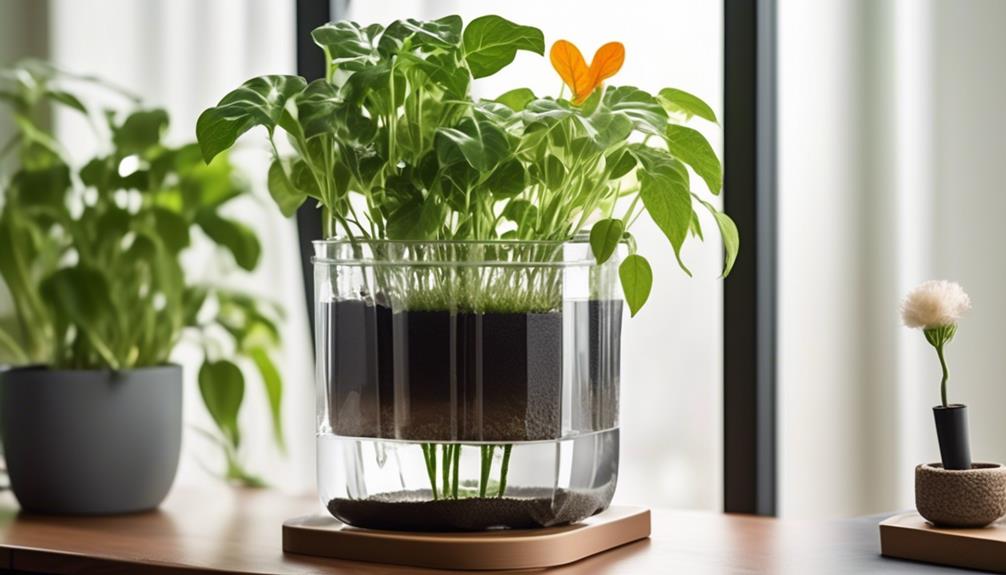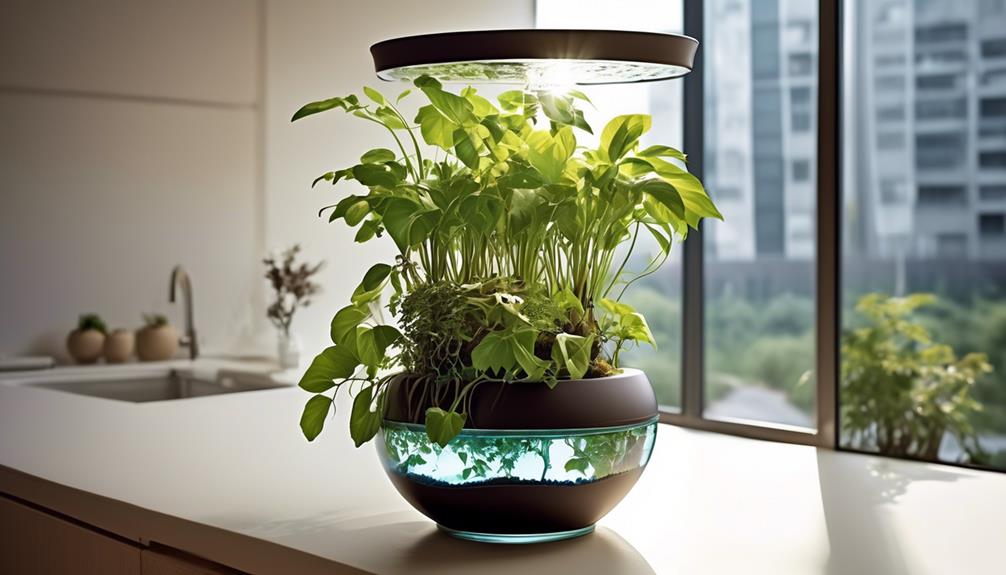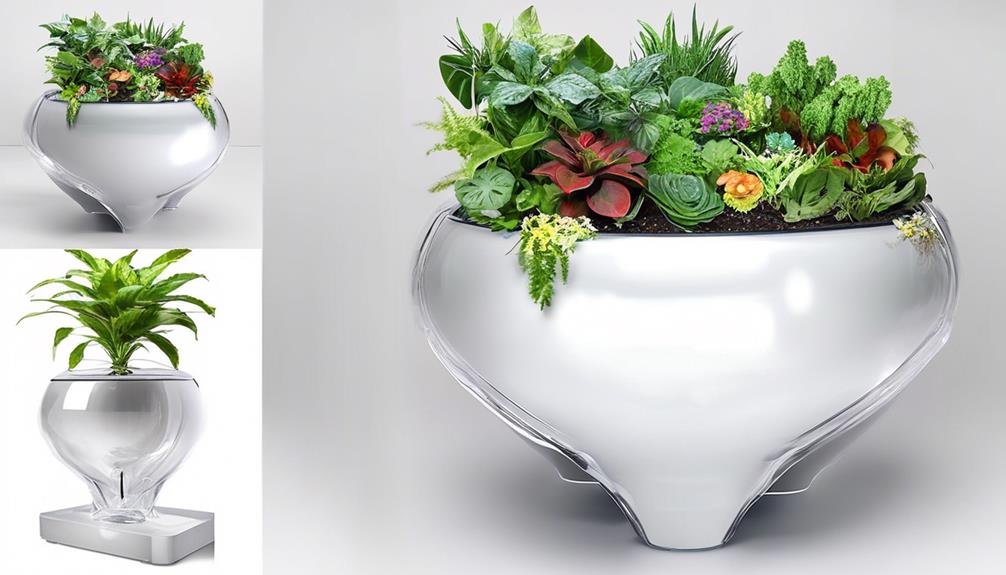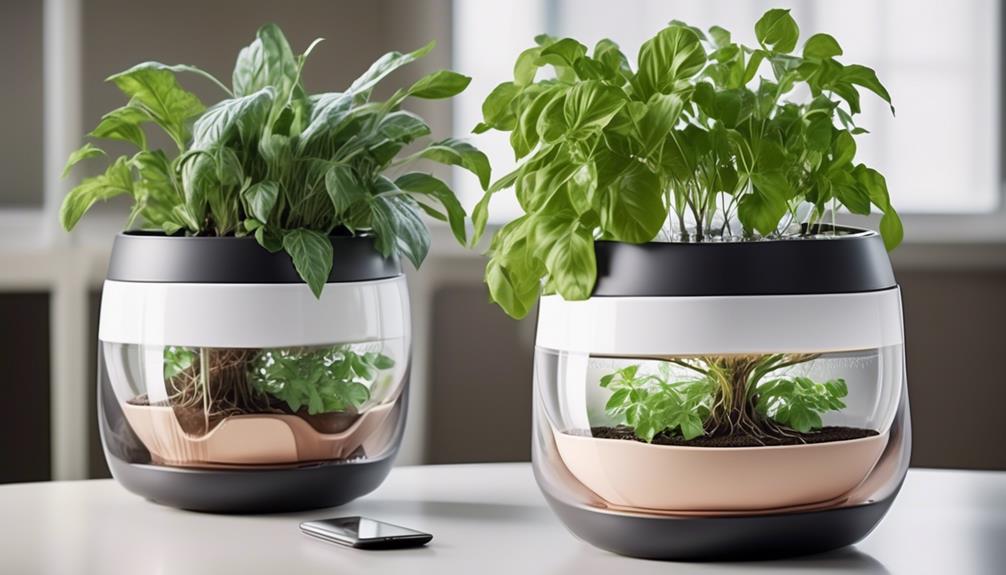Do you feel tired from always struggling to keep your plants alive?
Well, have you ever considered a self-watering plant pot? You might be surprised to learn that these innovative pots can make plant care a whole lot easier.
But how do they work, and are they really worth the investment?
Stick around to uncover the secrets behind self-watering plant pots and how they can transform the way you care for your beloved greenery.
Key Takeaways
- Self-watering plant pots use a reservoir system to provide a consistent water supply to plant roots.
- They have a wicking mechanism or water level indicator to ensure optimal hydration.
- Self-watering pots are beneficial for indoor gardening and maintaining moisture levels.
- They promote water efficiency, plant health, and are convenient for busy individuals.
How Self-Watering Plant Pots Work
Using a reservoir system, self-watering plant pots provide a consistent and controlled supply of water to the plant's roots. This watering automation is achieved through a wicking mechanism or a water level indicator, ensuring optimal plant hydration. The design of these pots is particularly beneficial for indoor gardening, where maintaining the right moisture levels can be challenging.
The reservoir, usually located at the bottom of the pot, holds the water. A wick, made of materials like cotton or nylon, extends from the reservoir into the soil. Through capillary action, the water moves up the wick and into the soil, keeping it consistently moist. This mechanism mimics the natural way in which plants absorb water from the ground.
Additionally, some self-watering pots are equipped with a water level indicator to prevent overwatering or underwatering. This feature is especially useful for those new to container gardening, as it provides a visual cue for when it's time to refill the reservoir. Understanding the functionality of self-watering pots is essential for anyone looking to optimize plant care through efficient watering solutions.
Benefits of Self-Watering Plant Pots

As plant enthusiasts, we appreciate the water efficiency that self-watering plant pots offer.
The innovative design ensures that plants receive just the right amount of water, reducing wastage and the need for frequent watering.
This not only promotes plant health but also provides a convenient solution for busy individuals or those with a penchant for travel.
Water Efficiency
With self-watering plant pots, the efficient delivery of water to the roots of the plants is facilitated by a specifically designed reservoir system. This technology offers several benefits in terms of water efficiency:
- Reduced Water Waste: Self-watering pots utilize a bottom-up watering technique, minimizing water evaporation and runoff. This conservation approach optimizes water usage, making it an environmentally friendly option.
- Consistent Plant Hydration: The reservoir system ensures a steady supply of water to the plant roots, preventing under or over-watering. This precise hydration technology promotes healthier plant growth and reduces water-related stress on the plants.
- Longer Watering Intervals: Self-watering pots have the capacity to store water for extended periods, reducing the frequency of watering. This not only saves time and effort but also conserves water resources effectively.
Plant Health
Employing a reservoir system that delivers water directly to the roots, self-watering plant pots promote optimal hydration and overall plant health. These pots ensure consistent moisture levels, preventing both under and over-watering, which can be detrimental to plant health.
By maintaining a balanced moisture level, self-watering pots support the uptake of essential nutrients, promoting robust growth and vibrant foliage. The controlled watering technique also prevents water stress, a common issue in conventional pots, which can lead to stunted growth and poor plant nutrition.
Additionally, the reservoir system reduces the risk of nutrient leaching, ensuring that valuable plant nutrition remains available to the roots. This efficient watering technique not only supports the overall health of the plant but also minimizes the risk of water-related diseases, ultimately contributing to the longevity of your green companions.
Types of Self-Watering Plant Pots
In self-watering plant pots, there are several distinct types, each designed to cater to specific plant care needs and environmental factors. When considering self-watering plant pots, it's essential to understand the different types available, as they can significantly impact the overall health and growth of your plants.
Here are some key types of self-watering plant pots:
- Material Options
- Plastic: Lightweight and affordable, plastic self-watering pots are durable and come in various colors and styles.
- Ceramic: These pots provide a more aesthetically pleasing option, offering a wide range of designs and colors to complement any indoor or outdoor space.
- Concrete: Ideal for outdoor use, concrete self-watering plant pots are sturdy and provide excellent stability for larger plants.
- Aesthetic Designs
- Traditional: These pots feature classic shapes and designs, perfect for a timeless look in any environment.
- Modern: Sleek and minimalist, modern self-watering pots offer a contemporary aesthetic that suits modern interior and exterior designs.
- Decorative: These pots come in unique and ornate designs, adding a decorative element to your plant display.
Understanding the different types of self-watering plant pots allows you to choose the best option for your specific plant care needs and aesthetic preferences.
Features to Look for in Self-Watering Plant Pots

When selecting self-watering plant pots, it is crucial to consider specific features that contribute to the effective and efficient care of your plants. The right self-watering pot can make a significant difference in the health and growth of your plants. Key features to look for include the materials used in the pot's construction and the design options available.
| Features | Description | Benefits |
|---|---|---|
| Self-Watering Pot Materials | Look for pots made from durable, non-porous materials such as plastic, ceramic, or glass. These materials help to retain moisture and prevent evaporation, promoting optimal hydration for plants. | Ensures consistent moisture levels, reduces the frequency of watering, and provides a stable environment for plant roots. |
| Design Options | Consider pots with built-in water reservoirs, wicking systems, and drainage control mechanisms. These features help regulate water intake and prevent overwatering, ensuring that plants receive the right amount of moisture. | Promotes healthier root growth, minimizes the risk of root rot, and allows for longer periods between watering. |
Plant Care Tips for Self-Watering Pots

When caring for plants in self-watering pots, it's important to consider the watering frequency and soil moisture levels.
Understanding the specific needs of each plant is crucial in maintaining optimal moisture levels within the pot.
Monitoring the soil moisture and adjusting the watering schedule accordingly will help ensure the health and vitality of the plants.
Watering Frequency
To ensure optimal growth and health of your plants in self-watering pots, it's essential to establish a suitable watering schedule that aligns with their specific moisture requirements. The innovative watering technology in self-watering pots maximizes water efficiency and automates plant hydration, but it's crucial to monitor the watering frequency to avoid overwatering or underwatering.
Here's a detailed guide to help you master the watering frequency for your self-watering pots:
- Understand your plant's moisture needs: Different plants have varied hydration requirements, so it's important to research and understand the specific needs of each plant species.
- Monitor the soil moisture: Regularly check the moisture level of the soil to determine when it's time to refill the water reservoir in the self-watering pot.
- Adjust based on environmental factors: Factors such as temperature, humidity, and sunlight can impact the watering frequency, so make adjustments accordingly.
Soil Moisture Levels
Understanding the moisture levels in the soil is a critical aspect of maintaining the health and growth of plants in self-watering pots. It allows for effective monitoring and adjustment of the watering schedule. Proper soil moisture management is essential for plant growth. In self-watering pots, the watering techniques impact soil moisture levels and ultimately affect root development.
Monitoring the soil moisture levels ensures that the plants receive adequate water without becoming waterlogged, which can lead to root rot. It also helps in preventing underwatering, which can stunt plant growth. By understanding the moisture needs of different plant species and adjusting the watering schedule accordingly, one can create an optimal environment for root development and overall plant health in self-watering pots.
Regularly checking and managing soil moisture levels is key to successful plant care in these innovative pots.
Choosing the Right Plants for Self-Watering Pots

Selecting suitable plant species for self-watering pots requires consideration of their water requirements, growth habits, and root systems to ensure optimal performance and health. When choosing plants for self-watering pots, it's essential to opt for species that thrive in indoor environments and have moderate water needs.
Additionally, selecting plants with compact root systems ensures they can effectively utilize the water provided in the self-watering pots. Here are some key factors to consider when choosing the right plants for self-watering pots:
- Drought Resistant Plants: Look for plants that have natural adaptations to survive in arid conditions. Examples include succulents like Aloe vera and Haworthia, as well as certain species of cacti, such as the Echinocactus grusonii (Golden Barrel Cactus).
- Indoor Gardening Benefits: Choose plants that offer the added benefits of indoor gardening, such as air purification and aesthetic appeal. Species like the Peace Lily (Spathiphyllum) and Snake Plant (Sansevieria) are excellent choices for self-watering pots due to their low maintenance requirements and air-purifying qualities.
- Moderate Water Needs: Select plants that have moderate water needs to ensure they can thrive in the self-watering pots without being overwatered. Examples include the Chinese Evergreen (Aglaonema) and the Spider Plant (Chlorophytum comosum), which are well-suited for self-watering systems due to their adaptability to varying moisture levels.
Careful consideration of these factors will help you choose the right plants for your self-watering pots, promoting healthy growth and minimizing maintenance efforts.
Setting Up a Self-Watering Plant Pot

We recommend preparing a self-watering plant pot by first selecting a suitable container with a water reservoir and a wicking system to efficiently provide water to the plant's roots. When setting up a self-watering plant pot, it is crucial to ensure that the wicking system is properly positioned to draw water from the reservoir and deliver it to the soil. Additionally, choosing the right soil mix is essential for optimal plant hydration. Here's a detailed breakdown of the components and steps involved in setting up a self-watering plant pot:
| Components | Description | Importance |
|---|---|---|
| Container | Select a pot with a water reservoir | Ensures consistent hydration |
| Wicking system | Position the wick to draw water from the reservoir | Facilitates water distribution |
| Soil mix | Choose a well-draining mix for efficient hydration | Provides optimal growing conditions |
| Water reservoir | Ensure proper water level maintenance | Sustains plant hydration |
Setting up a self-watering plant pot involves careful consideration of these components to create an environment conducive to plant hydration and growth. This method is particularly beneficial for container gardening, where maintaining consistent moisture levels is essential for plant health.
Maintaining Self-Watering Plant Pots

To ensure optimal functionality, it's essential to regularly monitor the water levels in the reservoir and adjust as needed to maintain consistent hydration for the plants. This is crucial for the overall health and growth of the plants.
Here are some key maintenance tips for self-watering plant pots:
- Regular Inspection: Check the water levels in the reservoir at least once a week, especially during hot weather or if the plants are growing rapidly. Ensure that the reservoir is neither completely dry nor overflowing.
- Cleaning and Refilling: Clean the reservoir every 2-4 weeks to prevent algae growth and mineral deposits. Refill with fresh water and add appropriate liquid fertilizer if needed, following the manufacturer's instructions.
- Troubleshooting Common Issues: Keep an eye out for signs of overwatering or underwatering, such as yellowing leaves or wilting. Adjust the watering system accordingly. Additionally, if there are any leaks or malfunctions in the self-watering mechanism, address them promptly to prevent damage to the plants.
Choosing the right size pot is also critical for the proper maintenance of self-watering plant pots. Ensure that the pot size matches the plant's root system and watering needs to avoid waterlogging or dehydration issues.
Frequently Asked Questions
Can Self-Watering Plant Pots Be Used for Outdoor Plants?
Yes, self-watering plant pots can be used for outdoor plants. They provide outdoor durability and regulate watering frequency by ensuring the plants receive consistent moisture.
The pots feature a reservoir that holds water, allowing the plants to draw moisture as needed. This system is especially beneficial for outdoor plants, as it helps maintain optimal hydration levels, reducing the need for frequent manual watering and ensuring the plants thrive in outdoor environments.
Are Self-Watering Plant Pots Suitable for All Types of Soil?
Absolutely, self-watering plant pots are suitable for a variety of soil types. Their design ensures consistent watering efficiency, making them compatible with different soil compositions. Whether it's sandy, loamy, or clay soil, the self-watering mechanism provides the right amount of moisture, promoting healthy plant growth.
This makes them a practical choice for plant enthusiasts seeking a low-maintenance solution for different soil types.
Do Self-Watering Plant Pots Require Any Special Maintenance or Cleaning?
Self-watering plant pots require special maintenance and cleaning. Proper maintenance tips involve regularly checking the water level and refilling as needed, as well as periodically flushing out the reservoir to prevent salt buildup.
The cleaning process includes removing any algae or mineral deposits from the water reservoir and ensuring the wick or watering mechanism is free of debris.
These practices help maintain optimal plant health and pot functionality.
Can Self-Watering Plant Pots Be Used for Hydroponic Gardening?
Yes, self-watering plant pots can be used for hydroponic gardening. They provide a convenient option for indoor gardening, offering a consistent water supply to plants. Compared to traditional watering methods, self-watering systems minimize the need for frequent maintenance, making them suitable for busy individuals.
However, drawbacks include the potential for overwatering and the need for periodic cleaning and maintenance to ensure optimal plant growth.
Are Self-Watering Plant Pots Suitable for All Types of Plants, Including Succulents and Cacti?
Yes, self-watering plant pots can be suitable for all types of plants, including succulents and cacti.
The key is to understand the specific watering needs of each plant type and adjust the watering system accordingly.
When choosing a self-watering pot for succulents and cacti, consider the plant pot materials, design, size, and drainage to ensure optimal care.
With proper attention to these details, self-watering pots can be a valuable tool for successful indoor gardening with succulents.
Can You Provide Examples of Self-Watering Plant Pots?
Sure! Examples of self-watering pot appearance include sleek, modern designs with built-in water reservoirs, stylish ceramic options with hidden water lines, and hanging planters with self-watering capabilities. These pots not only look great but also help to effectively keep plants hydrated.
Conclusion
In conclusion, self-watering plant pots are a convenient and efficient way to keep your plants healthy and thriving.
Did you know that self-watering pots can reduce water usage by up to 80% compared to traditional watering methods? This statistic highlights the environmental benefits of using self-watering plant pots, making them a great choice for eco-conscious gardeners.
So, consider investing in self-watering pots to save water and keep your plants happy.











